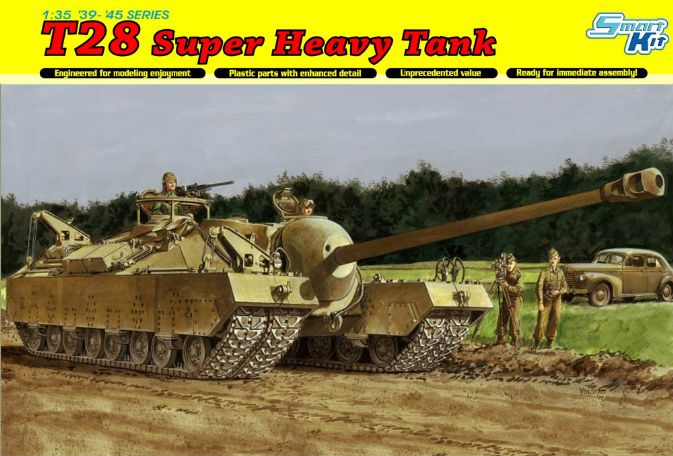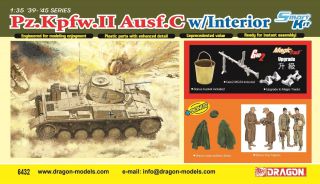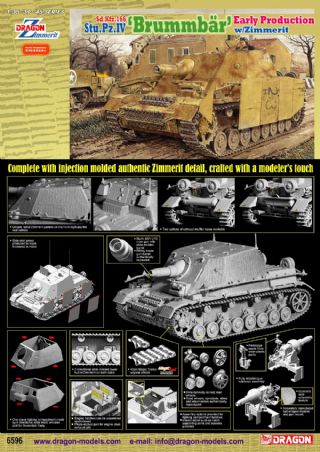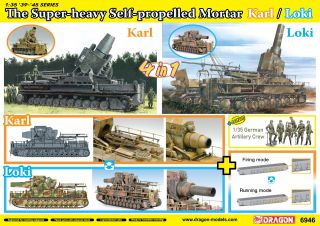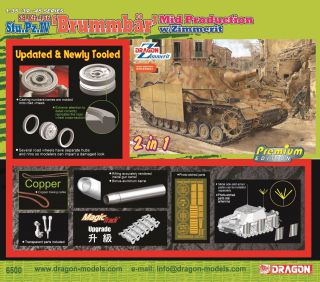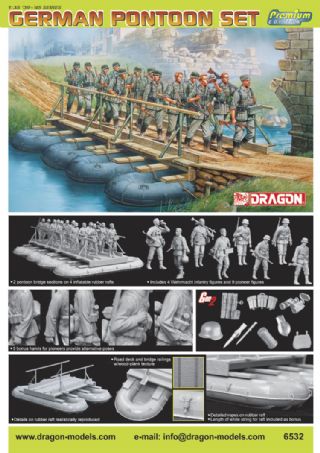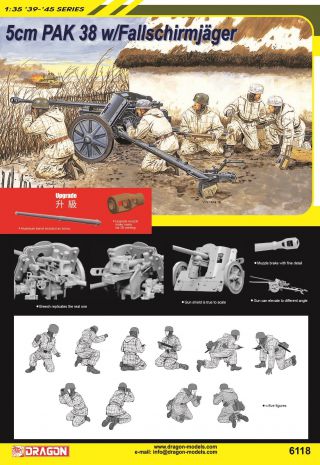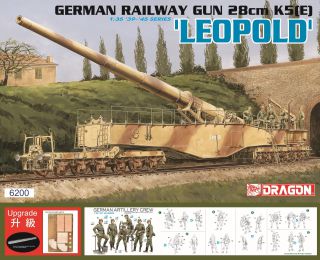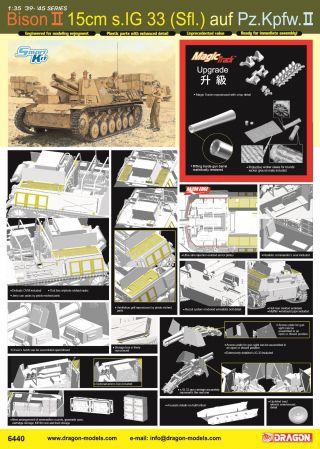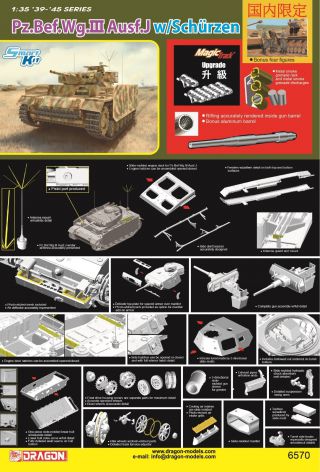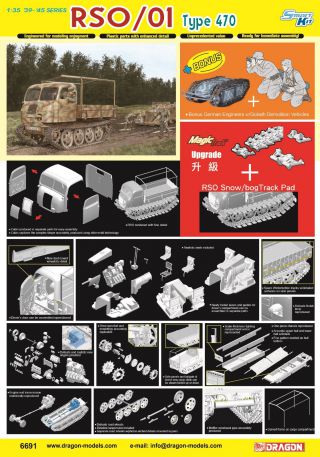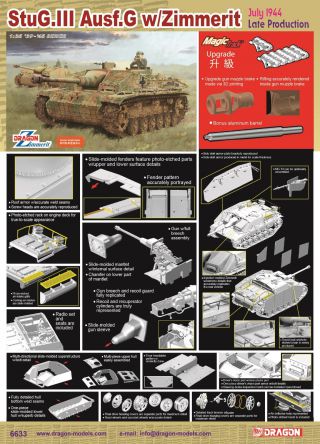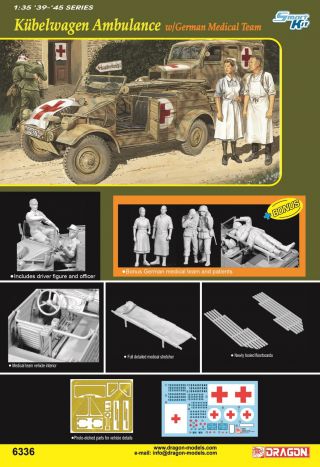HOME → Dragon Plastic Model Kits → 1/35 WWII Military → 6750

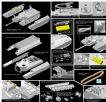
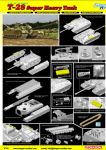







Bar Code: 0 89195 86750 6
Packaging: 12 pieces per master carton
Box Size: 270 x 420 x 95mm
Features:
- Newly tooled T28 rendered w/details
- Newly designed suspension system and realistically represented road wheels
- T28 can be assembled in either combat or travel modes
- On-vehicle tools reproduced
- .50-cal machine gun w/pedestal mount on casemate roof
- Cupola hatches can be assembled open/closed
- Hatches on engine deck can be assembled open/closed
- Round-shaped trunnions w/cast detail
- Bolted connecting plate for mantlet
- Aluminum gun barrel
- Track-removal jibs reproduced w/crisp detail
- Delicate cable guides molded on T28 side
- Intricate storage box provided
- One-piece lower hull offers easy assembly
- Intricate upper hull assembled from separate pieces
- Slide-molded one-piece hull body
- Bogies w/plunger springs reproduced
- Detailed sprockets w/fine details;
- Idler wheels have detailed parts
- Horns and protective brackets realistically reproduced
- DS tracks reproduced w/refined detail
This must surely be one of the most astonishing kits from Dragon this year! The excitement begins well before modelers open their box lids to reveal Dragon's first ever T28 Super Heavy Tank! And when they do view the contents, their jaws are sure to drop! The T28 was designated a Super Heavy Tank, and this 95-ton monstrosity was designed to breach the defenses of the Siegfried Line during the latter part of WWII. The T28 featured a 105mm T5E1 gun fitted in a fixed casemate instead of a traditional turret. The frontal armor was up to 305mm thick, sufficient to withstand the famous and super-effective German 8.8cm cannon. To cope with the immense weight, the vehicle ran on four sets of tracks instead of the usual two. However, its 500hp engine was underpowered to handle such bulk, meaning the T28 was slow (a 13km/h top speed) and cumbersome (military bridges of the day could not bear its weight). It was to operate with a four-man crew.
Befitting such an impressive subject, Dragon's engineers have gone all out to create a stunning 1/35 scale kit of the American behemoth. Needless to say, most parts on this T28 Super Heavy Tank, except for the suspension, wheels and cupola, are newly tooled. New components include the lower and upper hulls that are created by slide molds so as to fit together precisely. The cast texture on the upper hull is realistically incorporated too.
The size of the model is simply overwhelming - more than 300mm long! The double track runs are made from brand new DS tracks, and the outer tracks can be detached just like the real ones should a modeler decide to opt for this configuration. The gun barrel is produced in aluminum. This was a monster of a tank, but Dragon has been careful to fill it out with sharp detail and easy-to-assemble components. The American T28 takes Dragon's title as the new super heavy tank of its 1/35 kit range!
Reviews:
T28 Super Heavy Tank
Manufacturer: Dragon Models
Scale: 1/35
Material: Styrene, aluminium & photo-etch
Serial Number: 6750
Price: TBA
Dragon:
Designated a Super Heavy Tank, this 95-ton monstrosity was designed to breach the defences of the Siegfried Line during the latter part of WWII. The T28 featured a 105mm T5E1 gun fitted in a fixed casemate instead of a traditional turret. The frontal armour was up to 305mm thick, sufficient to withstand the famous and super-effective German 8.8cm cannon. To cope with the immense weight, the vehicle ran on four sets of tracks instead of the usual two. However, its 500hp engine was underpowered to handle such bulk, meaning the T28 was slow (a 13km/h top speed) and cumbersome (military bridges of the day could not bear its weight). It was to operate with a four-man crew.
The Kit Contents
It's very unusual that Dragon send out kits in anything other than their standard boxes. Oh sometimes they're slightly taller than usual...but the same footprint. The one that this one comes in is a little larger than usual. Even the lid is made from corrugated cardboard to withstand the strain! If you look at the sprue photographs below you'll be able to see what I'm getting at. One of the large sprues has a number '8' on it. So there are 8 of that particular sprue in the kit. There are other multiples too. Eight sets of tracks, a huge aluminium barrel, thirty-two metal springs. It's become almost a cliche now when somebody said they had a hard time getting the contents back into the box. I tried...I gave up. Seriously. I'm going to have to build it.
I have to admit, I'm not a big Allied fan. I hadn't known of this vehicle's existence before it came up on the Dragon radar. Now that I have the kit in front of me I'm transfixed by it. It's huge! Those fenders in the first sprue photograph are each 22cm long!
Rather unhappily, construction begins with the suspension and running gear. It's bad enough on a normal sized vehicle, but on this one it seems never-ending. Nice to get it out of the way early though I suppose. The suspension and wheels, as you would expect, are not really new. We've seen them before in earlier Dragon releases. Just not so many of them. Each HVSS unit consists of two pairs of wheels, and there are eight of them on each inner track run, and a further eight on each outer run. That's sixty-four roadwheels. Each HVSS unit consists of two of the real metal springs, and as long as you have miniature fingers (ten on each hand) and somebody to catch them when they 'ping', you'll be alright. I haven't had as much fun since that dental abscess a few years ago. I have to admit that they look really good once they're done...and if you're careful they actually work too. You'll get the hang of it after fifteen or so.
The first run of suspension bogies are fixed to the outer wall of the lower hull...which is huge! At this point, Dragon directs you to fix the brushguards for the lights. I wouldn't. Not of you'd like them to be still there when you've finished. The rear wall of the lower hull is also fixed at this point, and it's moulded with the two huge final drive bulges in place. In addition to the return rollers and just below them, there are small pedestals provided with etched mud scrapers.
Putting the lower hull aside for now, we're next instructed to begin fixing detail to each of the outer track assemblies, such as more brushguards for the lights, various tools, and the lifting hooks and gear for lifting them into and out of place. If you're in any state to continue at this point, then it's time to fix the next batch of suspension bogies to the inside surface of each of the outer track covers. Each of these outer track assemblies feels almost a model in itself. Absolutely covered in detail, with almost all of their upper surface having something to be fixed in place, be it a tool, toolbox, of lifting point.
The upper superstructure is of course another brand new part. Fitted with two cupola's, each of which has clear parts for the periscopes, plus separate hatch with extremely fine casting numbers embossed onto their surfaces, and there's a circular skate ring that mounts a .50 cal machine gun, around the rearmost cupola. Each of the two large air intakes areas on the engine deck at the rear is supplied with a large solid armoured cover. The main gun is supplied with a turned aluminium barrel, just over 13 centimetres long, and the large double muzzle brake at the end is supplied as one large slide moulded part. The gun barrel fit's into the large dome-shaped mantlet...and it's fixed in such a way that it remains free to elevate or depress. There's no inside detail whatsoever provided for the vehicle, and that includes the breech...of which there isn't one. :)
The tracks supplied with the kit are of the T-80 steel chevron type. We're
supplied with eight lengths moulded from their DS 100 vinyl, the idea being
to join two lengths together to make up one track, of which you'll need four
of course. They're actually quite nice, the only not so nice part being the
injection moulded guide horns supplied on four small sprues. Take 'em off, clean
'em up, stick 'em on. Then do it all again. And there was I thinking the suspension
bogies were a bit tedious. Lastly, the two winch assemblies are fixed into place,
the position of which isn't fixed, since apparently they were able to be moved
between different point on the upper hull. Show on the instructions is the option
of having each of the outer track assemblies detached and in towing mode, although
according to the one photograph I've seen of them in this position, each of
the upper track runs should be boxed in, rather than left open as in the depiction
on the instructions.
There are decals included, although these just consist of minimal marking as for the prototype shown in the scans below.
Conclusion
There are some pretty tiresome, tedious, repetitive tasks that are going to have to be undertaken when building this one...but it's just so unusual that I still really, really want to build one! Superb moulding, fantastic detail, and a really imposing size. Recommended.
- Vinnie Branigan

